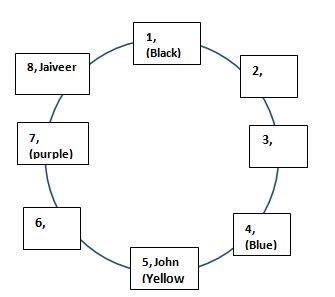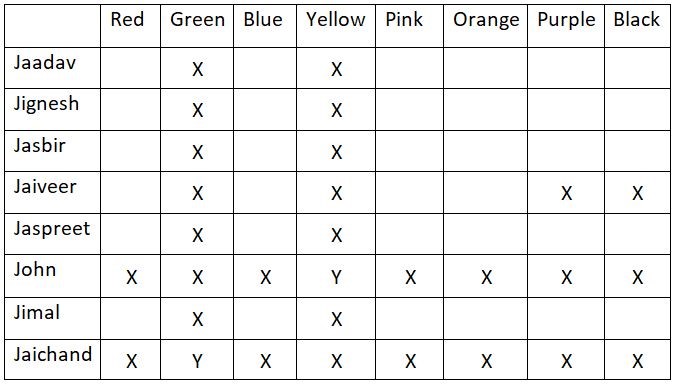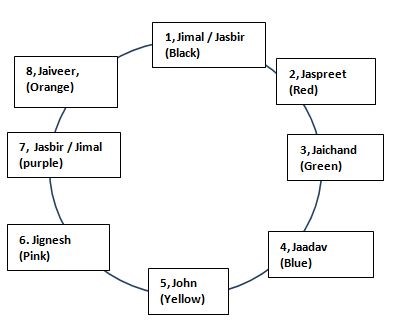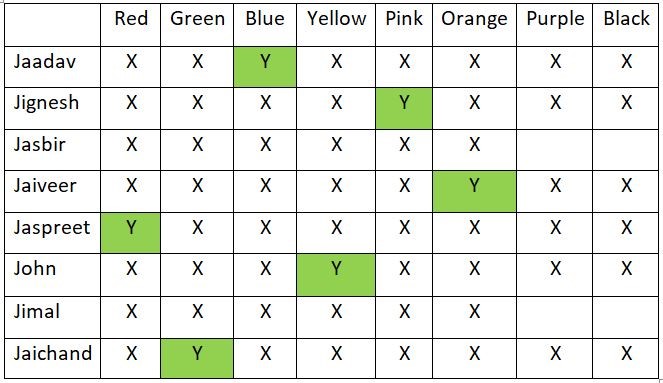Question
If Jimal is third to the right of Jaspreet, then who
among the following is on the immediate left of Jignesh? Study the following information and answer the questions based on it. 1. Eight boys Jaadav, Jignesh, Jasbir, Jaiveer, Jaspreet, John, Jimal and Jaichand are sitting around a circular table facing the centre. All of them have a different favourite colour, viz Red, Green, Blue, Yellow, Pink, Orange, Purple and Black but not necessarily in the same order. 2. John is third to the right of Jaiveer, who does not like Purple or Black. 3. The one who likes Orange is an immediate neighbor of Jimal and Jasbir. 4. The one who likes Purple is second to the left of John, who likes Yellow. The one who likes Black is opposite John. 5. Jaichand is not an immediate neighbor of either Jasbir or John but is third to the right of Jignesh. The persons who like Orange and Blue sit opposite each other. 6. Jaichand likes Green. The one who likes Purple sits third to the left of the one who likes Blue. 7. The one who likes Red and the one who likes Black are immediate neighbours. Jaadav does not like Red. 8. Jaspreet is second to the right of Jaadav, who is an immediate neighbor of John and Jaichand.Solution
From 1, 2, 4, 6 From 3, 4, 6
From 3, 4, 6 We know that Jaspreet is second to the right of Jaadav, who is an immediate neighbor of John and Jaichand. John sits at 5. Thus, Jaichand can either be seated at 7 or 3. But the person sitting at 7 has purple as the favourite colour. But Jaichand’s favourite colour is green. Thus Jaichand sits at 3 and Jaadav sits at 4. And hence, Jaspreet sits at 2. Also, the ones who like orange and blue sit opposite each other. Thus, Jaiveer likes Orange. Also, The one who likes Red and the one who likes Black are immediate neighbours. The only possibility for red to be sated is at 2 (8 already occupied). Thus, the one who likes pink is seated at 6. Jaichand is not an immediate neighbor of either Jasbir or John but is third to the right of Jignesh. Thus Jignesh sits at 6. The one who likes Orange is an immediate neighbor of Jimal and Jasbir. The exact positions for Jimal and Jasbir are not clear from the given data. Thus, either of them can be seated at 1 and 7
We know that Jaspreet is second to the right of Jaadav, who is an immediate neighbor of John and Jaichand. John sits at 5. Thus, Jaichand can either be seated at 7 or 3. But the person sitting at 7 has purple as the favourite colour. But Jaichand’s favourite colour is green. Thus Jaichand sits at 3 and Jaadav sits at 4. And hence, Jaspreet sits at 2. Also, the ones who like orange and blue sit opposite each other. Thus, Jaiveer likes Orange. Also, The one who likes Red and the one who likes Black are immediate neighbours. The only possibility for red to be sated is at 2 (8 already occupied). Thus, the one who likes pink is seated at 6. Jaichand is not an immediate neighbor of either Jasbir or John but is third to the right of Jignesh. Thus Jignesh sits at 6. The one who likes Orange is an immediate neighbor of Jimal and Jasbir. The exact positions for Jimal and Jasbir are not clear from the given data. Thus, either of them can be seated at 1 and 7 

What is a Follow-on Public Offer (FPO)?
Who is required to comply with the Business Responsibility and Sustainability Report (BRSR) guidelines, as introduced by SEBI?
In India, NIFTY and SENSEX are calculated on the basis of
Which section of SARFAESI Act deals with measures of Asset Reconstruction?
Which of the following statements correctly reflects the requirements regarding the maximum number of directorships an individual can hold as per the Co...
In which of the following facility the borrower can take money out as needed until the limit is reached, and as money is repaid, it can be borrowed again?
If a person is missing then after how many years is that person considered deceased after the complaint is filed?
Calculate the asset turnover from the above information
Which of the following correctly describes the term "group of connected borrowers" under the UCB exposure norms?
As per ERG theory, which of the following needs had motivated RAM to join ABC Ltd?
Relevant for Exams:


